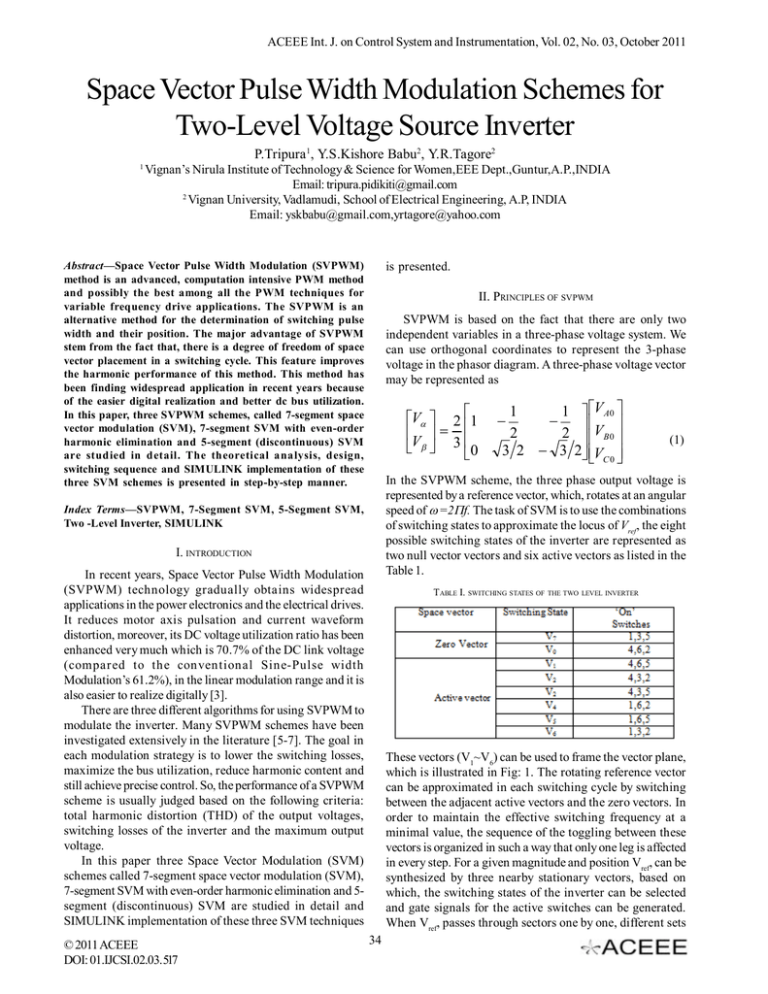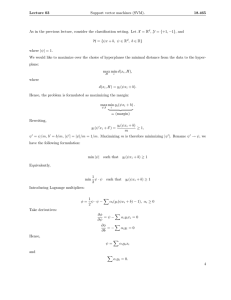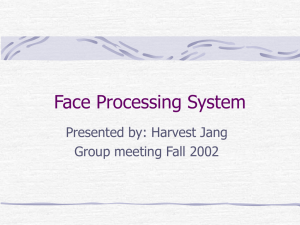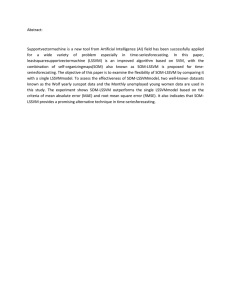
ACEEE Int. J. on Control System and Instrumentation, Vol. 02, No. 03, October 2011
Space Vector Pulse Width Modulation Schemes for
Two-Level Voltage Source Inverter
P.Tripura1, Y.S.Kishore Babu2, Y.R.Tagore2
1
Vignan’s Nirula Institute of Technology & Science for Women,EEE Dept.,Guntur,A.P.,INDIA
Email: tripura.pidikiti@gmail.com
2
Vignan University, Vadlamudi, School of Electrical Engineering, A.P, INDIA
Email: yskbabu@gmail.com,yrtagore@yahoo.com
Abstract—Space Vector Pulse Width Modulation (SVPWM)
method is an advanced, computation intensive PWM method
and possibly the best among all the PWM techniques for
variable frequency drive applications. The SVPWM is an
alternative method for the determination of switching pulse
width and their position. The major advantage of SVPWM
stem from the fact that, there is a degree of freedom of space
vector placement in a switching cycle. This feature improves
the harmonic performance of this method. This method has
been finding widespread application in recent years because
of the easier digital realization and better dc bus utilization.
In this paper, three SVPWM schemes, called 7-segment space
vector modulation (SVM), 7-segment SVM with even-order
harmonic elimination and 5-segment (discontinuous) SVM
are studied in detail. The theoretical analysis, design,
switching sequence and SIMULINK implementation of these
three SVM schemes is presented in step-by-step manner.
is presented.
II. PRINCIPLES OF SVPWM
SVPWM is based on the fact that there are only two
independent variables in a three-phase voltage system. We
can use orthogonal coordinates to represent the 3-phase
voltage in the phasor diagram. A three-phase voltage vector
may be represented as
V 2 1
V
3 0
V A0
VB 0
2 VC 0
(1)
In the SVPWM scheme, the three phase output voltage is
represented by a reference vector, which, rotates at an angular
speed of =2f. The task of SVM is to use the combinations
of switching states to approximate the locus of Vref , the eight
possible switching states of the inverter are represented as
two null vector vectors and six active vectors as listed in the
Table 1.
Index Terms—SVPWM, 7-Segment SVM, 5-Segment SVM,
Two -Level Inverter, SIMULINK
I. INTRODUCTION
In recent years, Space Vector Pulse Width Modulation
(SVPWM) technology gradually obtains widespread
applications in the power electronics and the electrical drives.
It reduces motor axis pulsation and current waveform
distortion, moreover, its DC voltage utilization ratio has been
enhanced very much which is 70.7% of the DC link voltage
(compared to the conventional Sine-Pulse width
Modulation’s 61.2%), in the linear modulation range and it is
also easier to realize digitally [3].
There are three different algorithms for using SVPWM to
modulate the inverter. Many SVPWM schemes have been
investigated extensively in the literature [5-7]. The goal in
each modulation strategy is to lower the switching losses,
maximize the bus utilization, reduce harmonic content and
still achieve precise control. So, the performance of a SVPWM
scheme is usually judged based on the following criteria:
total harmonic distortion (THD) of the output voltages,
switching losses of the inverter and the maximum output
voltage.
In this paper three Space Vector Modulation (SVM)
schemes called 7-segment space vector modulation (SVM),
7-segment SVM with even-order harmonic elimination and 5segment (discontinuous) SVM are studied in detail and
SIMULINK implementation of these three SVM techniques
© 2011 ACEEE
DOI: 01.IJCSI.02.03.517
1
1
2
2
3 2 3
TABLE I. SWITCHING STATES OF THE TWO LEVEL INVERTER
These vectors (V1~V6) can be used to frame the vector plane,
which is illustrated in Fig: 1. The rotating reference vector
can be approximated in each switching cycle by switching
between the adjacent active vectors and the zero vectors. In
order to maintain the effective switching frequency at a
minimal value, the sequence of the toggling between these
vectors is organized in such a way that only one leg is affected
in every step. For a given magnitude and position Vref, can be
synthesized by three nearby stationary vectors, based on
which, the switching states of the inverter can be selected
and gate signals for the active switches can be generated.
When Vref, passes through sectors one by one, different sets
34
ACEEE Int. J. on Control System and Instrumentation, Vol. 02, No. 03, October 2011
vector determines the SVM scheme. There are a few options:
the null vector V0 only, the null vector V7 only, or a combination
of the null vectors. A popular SVM technique is to alternate
the null vector in each cycle and to reverse the sequence
after each null vector. This will be referred to as the symmetric
7-segment technique. Fig. 3 shows conventional 7-segment
switching sequences of sector I. It is shown that the sequence V0-V1-V2-V0 is used in the first Ts/2, and the sequence
V0-V2-V2-V0 is used in the second Ts/2. The sequences are
symmetrical. The switching frequency is the same as sampling frequency of the inverter.
of switches will be turned on and off .As a result, when Vref,
rotates one revolution in space, the inverter output voltage
varies one cycle over time.
Fig.1. Switching vectors hexagon
Three stationary vectors can synthesize the reference Vref.
The dwell time for the stationary vectors essentially
represents the duty-cycle time (on-state or off-state time) of
the chosen switches during a sampling period Ts of the
modulation scheme. The dwell time calculation is based on
‘volt-second balancing’ principle, that is, the product of the
reference voltage Vref and sampling period Ts equals the sum
of the voltage multiplied by the time interval of chosen space
vectors. For example, when Vref falls into sector I as shown in
Fig: 2, it can be synthesized by V1, V2 and V0.The volt second
balance equation is
Fig.3. 7-Segment Switching Sequence for Vref in sector I
The SIMULINK Implementation of the system has been
carried out in the following sequence:
Calculation of 3 phase voltages (MATLAB Fcn is used)
Calculation of V alpha and V bheta (3 phase to 2 phase
transformation block is used)
Calculation Vref and alpha (Polar to Rectangle block is used.
The inputs to this block are Valpha and Vbheta and outputs of
this block are Vref and alpha.)
Calculation of Ta, Tb, T0 (Sub-system is shown in Fig.9)
Calculation of sector value
Calculation cumulative sum of Ta, Tb, T0 (Sub-system is
shown in Fig. 10)
Calculation of Tn (Sub-system is shown in Fig. 11)
Determination of switching states (look-up table is used
Realization of switching states (multi-port switch is used)
Derivation of 6 individual gate pulses to two level inverter
Vref Ts V1T0 V2Tb V0T0
(2)
TS Ta Tb Tc
Fig.2. Vref synthesized by V1, V2 and V0
For linear modulation range, the dwell times can be
calculated as:
Ta
Tb
3TsV ref
Vd
3TsVref
Vd
IV. 7 SEGMENT SVM WITH EVEN ORDER HARMONIC ELIMINATION
From the results of 7 segment SVM, it is clear that, the
line-to-line voltage waveform contains even order harmonics.
Since, most IEEE standards have more stringent requirements
on even-order harmonics than odd-order harmonics; this
section presents a modified SVM scheme with even-order
harmonic elimination. To investigate the mechanism of even
order harmonic elimination two switching sequences for the
Vref falls into sector IV are shown in Fig: 4. & Fig: 5. Space
vector diagram is shown in Fig: 6.
sin
3
sin( ),0
3
(3)
T0 Ts Ta Tb
II. 7 SEGMENT SPACE VECTRO MODULATION
The sector judgment and application time of active vector
for all SVM strategies are the same. The choice of the null
© 2011 ACEEE
DOI: 01.IJCSI.02.03.517
35
ACEEE Int. J. on Control System and Instrumentation, Vol. 02, No. 03, October 2011
Realization of switching states (same as in the 7 segment
model)
Derivation of 6 individual gate pulses to two level inverter
V. FIVE SEGMENT SVM
The switching sequence design is not unique for a given
set of stationary vectors and dwell times. Fig: 7 shows two
five-segment switching sequences and generated inverter
terminal voltages for Vref in sector I. For type-A sequence,
the zero switching sate [OOO] is assigned for V0 while typeB sequence utilizes [PPP] for V0.
In the five-segment sequence, one of the three inverter
output terminals is clamped to either the positive or negative
dc bus without any switching’s during the sampling period
Ts. Furthermore, the switching sequence can be arranged
such that the switching in an inverter leg is continuously
suppressed for a period of 2*pi/3 per cycle of the fundamental
frequency.
Fig.4. Type A Switching Sequence for Vref in sector IV [start and
ends with (0,0,0)]
Fig.5. Type B Switching Sequence for Vref in sector IV [start and
ends with (P,P,P)]
To make the three-phase line-to-line voltage half-wave
symmetrical, Type-A and Type-B switching sequences can
be alternatively used. In addition, each sector in the space
vector diagram is divided into two regions as shown in Fig. 6.
Type-A sequence is used in the non-shaded regions, while
type-B sequence is employed in the shaded regions.
Fig.7. Five Segment switching sequence
The SIMULINK Implementation of the system has been
carried out in the following sequence
Calculation of 3 phase voltages (same as in the 7 segment
model)
Calculation of Valpha and Vbheta (same as in the 7 segment
model)
Calculation Vref and alpha (same as in the 7 segment model)
Calculation of Ta, Tb, T0 (same as in the 7 segment model)
Calculation of sector value (same as in the 7 segment model)
Calculation cumulative sum of Ta, Tb, T0 (Sub-system is
shown in Fig.14)
Calculation of Tn (Sub-system is shown in Fig.15)
Determination of switching states (look-up table is used)
Realization of switching states (different from 7 segment
model)
Derivation of 6 individual gate pulses to two level inverter
Fig.6. Space vector diagram for even order harmonic elimination
The SIMULINK Implementation of the system has been
carried out in the following sequence:
Calculation of 3 phase voltages (same as in the 7 segment
model)
Calculation of Valpha and Vbheta (same as in the 7 segment
model)
Calculation Vref and alpha (same as in the 7 segment model)
Calculation of Ta, Tb, T0 (same as in the 7 segment model)
Calculation of sector value (This step is different from
previous model. Here 12 sectors are calculated each with 30o)
Calculation cumulative sum of Ta, Tb, T0 (same as in the 7
segment model)
Calculation of Tn (same as in the 7 segment model)
Determination of switching states (look-up table is used)
© 2011 ACEEE
DOI: 01.IJCSI.02.03.517
VI. MATLAB/SIMULINK MODELS OF THREE SVM SCHEMES
This section details the step-by-step development of
MATLAB/SIMULINK models of the three SVM schemes.
36
ACEEE Int. J. on Control System and Instrumentation, Vol. 02, No. 03, October 2011
A. Simulink model of 7-Segment SVM
B. Simulink model of 7-Segment SVM with even order
harmonic elimination
Fig.12. SIMULINK model of 7-Segment SVM with even order
harmonic elimination
C. Simulink model of 5-Segment SVM
Fig.8. SIMULINK model of 7-Segment SVM
Fig.13. SIMULINK model of 5-Segment SVM
Fig.9. SIMULINK model of Ta, T b, T 0 calculator
Fig.14. SIMULINK model of Cumulative sum calculator for 5Segment SVM
Fig.10. SIMULINK model of cumulative some calculator
Fig.15. SIMULINK model of T n block for 5-Segment SVM
Fig.11. SIMULINK model of T n block
© 2011 ACEEE
DOI: 01.IJCSI.02.03.517
37
ACEEE Int. J. on Control System and Instrumentation, Vol. 02, No. 03, October 2011
VII. SIMULATION RESULTS
VIII. CONCLUSIONS
Simulink models for the three SVM schemes were built
respectively and the models were run according to the
following data: DC Link Voltage Vd=5883 V, output line voltage
line voltage frequency=60Hz, R=16.4, L=14.2 mH. The
simulation results were presented for ma=0.8, f1=60 Hz, and
Ts=1/720 sec. for all the three schemes.
SVM is a popular choice in the inverter control. Three
SVM schemes are presented and analyzed through
simulation. The comparison study shows that all the three
SVM schemes can obtain the same output voltage in linear
modulation region. It was observed from the harmonic
spectrum of three schemes, the 7-segment SVM scheme
performs better in terms of THD of the output line voltage. It
is also observed that the THD of the 5-segment SVM lies
between the THD of 7-segment SVM and &7-segment SVM
with even order harmonic elimination.
REFERENCES
[1] Bin Wu, High-Power Converters and AC Drives. IEEE Press,
2006.
[2] M.Rashid, Power Electronics Pearson Prentice Hall,3/e 2007.
[3] B. K. Bose, Power Electronics and AC Drives. Pearson Prentice
Hall, 2006.
[4] Ned Mohan, Undeland and Robbins, Power Electronics. Wileyedition, 2007.
[5] Atif Iqbal, Adoum Lamine, Imtiaz Asharf and Mohibullah,
“MATLAB/SIMULINK model of space vector pwm for threephase voltage source inverter,” in Proc UPEC, 2006, p. 1096-1100.
[6] Wei-Feng Zhang and Yue-HuiYu, “Comparison of Three
SVPWM Schemes,” in Proc of Journal of Electronic Science and
Technology fo China, Vol.5, No.3 September 2007 p.283-287
[7] Xiang Shaobang and Hhao Ke-You, “Research on a Novel
SVPWM Algorithm ,” in Proc. of 2007 Second IEEE Conference on
Industrial Electronics and Applications p.1869-187.
[8] Baohua Lang, Miao miao, Weiguo Liu and Guangzhao Luo
“Simulation and Experiment Study of Space Vector Pulse Width
Modulation,” in Proc of The Ninth International Conference
onElectronic Measurement & Instruments-ICEMI’2009 pg.1-4081-412.
[9] H. W. van der Broeck, H.-C. Skudelny, and G. V. Stanke,
“Analysis and realization of a pulse width modulator based on
voltage space vectors,” IEEE Trans. Industry Applications, vol.
24, no. 1, pp. 142- 150, 1988.
[10] C. Attaianese, V. Nardi, and G. Tomasso, “A novel SVM
strategy for VSI dead-time-effect reduction,” IEEE Trans. Industry
Applications, vol. 41, no. 6, pp. 1667-1674, 2005.
[11] A. M. Trzynadlowski, R. L. Kirlin, and S. F. Legowski, “Space
vector PWM technique with minimum switching losses and a
variable pulse rate [for VSI],” IEEE Trans. Industrial Electronics,
vol. 44, no. 2, pp. 173-181, 1997.
[12] B. Hariram and N. S. Marimuthu, “Space vector switching
patterns for different applications –a comparative analysis,” in
Proc. IEEE International Conference on Industrial Technology, Hong
Kong, 2005, pp. 1444-1449.
Fig. 16. Waveform and FFT analysis of Vab for ma=0.8, f1=60 Hz,
and T s =1/720 sec 7-segment svm
Fig. 17. Waveform and FFT analysis of Vab for ma=0.8, f1=60 Hz,
and T s =1/720 sec 7-segment SVM with even order harmonic
elimination
Fig. 18. Waveform and FFT analysis of Vab for ma=0.8, f1=60 Hz,
and T s=1/720 sec 5-segment SVM
© 2011 ACEEE
DOI: 01.IJCSI.02.03.517
38







